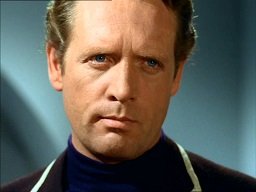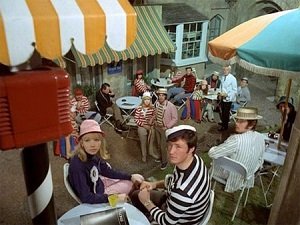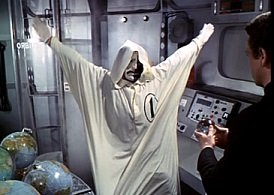The Prisoner: More Than A Number
There’s always an elephant in the room when the premise of a show is something that the main characters are trying to overcome. Whenever the crew on Star Trek Voyager think they’ve found a way home, you know it’s doomed to fail. Gilligan’s never getting off his Island. Mulder’s never going to find definitive proof of the conspiracy. But without that possibility, there’s no tension. And if you do let them resolve their issues, then that can backfire spectacularly – Twin Peaks nosedived once Laura Palmer’s murderer was revealed, and it’s notable that Frost & Lynch never intended the mystery to be solved. But there’s an alternative – set up two competing goals. Give your hero something to strive for, but also something to defend. This was the course plotted by The Prisoner.

The Prisoner was the creation of Patrick McGoohan and George Markstein, the team behind a hit series (at the time) called Danger Man. Danger Man had premiered in 1960 to some success – not enough to get it a second season, but enough to get McGoohan offered a film role. The role was as James Bond in Dr No (yes, the part that went to Sean Connery) but he turned it down on moral grounds. The staunchly Catholic McGoohan disapproved of Bond, and the character was almost the antithesis of John Drake, his character in Danger Man. Ironically it was the success of James Bond that led to Danger Man being re-commissioned for three more seasons. When McGoohan declined to do a fifth season Lew Grade, managing director of ATV, asked him what type of series he’d be willing to stay and do. McGoohan went and consulted with Markstein, and returned with the outline for something different. A series about paranoia, about the surveillance state, about the strange unsettling nature of the overly friendly smile. And so The Prisoner was born.
The setup for the show is shown in the first episode in a wordless set of scenes. A secret agent (similar in character to John Drake, though never explicitly stated to be him) angrily resigns his post, then returns home. While he packs his bags, someone squirts knockout gas into his flat and kidnaps him. He awakens in an exact duplicate of his flat – but outside is The Village, an apparently idyllic little seaside town. Yet nobody here has a name – just a number. His number, they tell him, is Six. The Village is run by Number Two. When he asks who is Number One, he is merely answered with mocking laughter. His attempts to escape fail – the bounds of the Village are patrolled by Rover, a mysterious white sphere that envelops and suffocates those it attacks. [1] They want to know why he resigned – but he refuses to tell them.

It’s a beautifully simple premise, and Six’s attempts to escape form one of the backbones of the series – though, as we know, he is doomed to fail. In one episode he tries desperately to find a way simply to tell who in the Village is a jailer, and who a fellow captive, but even here he fails. Yet mixed in with these are the attempts of the various Twos (the position being filled by a new person every episode, with a few repetitions) to force him to explain why he resigned, or confirm their pet theory – and here, he wins. Sometimes the two cross over – in one episode he is tricked into thinking he has escaped, and is about to give up his information when he realised the plot. In another, he manages to foil a plot to drive him insane using a man surgically altered to resemble him, and by taking the man’s place is on the verge of escape – though, of course, he fails.
Not all the episodes fall into these categories, of course. The Village is bigger than Six, and sometimes he finds himself caught up in other plots. When the Village becomes the testing ground for a supercomputer, he manages to destroy it. But when a friend of his appears as a fellow prisoner, he cannot save him. Some are even stranger – one episode consists entirely of a surreal tale he tells a child of one of his former adventures, while another takes place in a Wild West version of the Village – though of course, all is not as it seems. And in my favourite episode, Hammer Into Anvil, Number Six turns the tables on a particularly sadistic Two by gaslighting him into committing treason against his employers and sealing his fate.

Nowadays, however, The Prisoner is perhaps best remembered for its finale – an outright dadaist episode that explains little or nothing about the mysteries of the show. Stories vary as to why. Markstein (who left the show two thirds of the way through its run) claimed that his vision had been to reveal that Number Six was John Drake, and to explore the show’s themes in other locales outside the Village – with the idea being that even if he escaped, he was still a prisoner of what he’d become. McGoohan disliked the idea however, and it was dropped along with Markstein. The most often-repeated story is that McGoohan was told a week before filming on the episode was due to begin that it was to be the finale, due to falling ratings, and scrambled to produce something in time. This is contradicted by a lot of sources, however, and the more likely version is that when McGoohan left for Hollywood to film his part in the movie Ice Station Zebra he was told that rather than receiving a second series of another thirteen episodes, instead he was going to receive four more episodes and that would be it. The problem was, though he’d assured Grade that there was a Master Plan, in truth having abandoned Markstein’s scheme he had nothing. None of the last four episodes produced were The Prisoner in any meaningful way – in addition to the previously mentioned Wild West and children’s story episodes, one was an episode where a different actor portrayed Six for most of the episode (explained as a mind swap) because McGoohan was still in America. It seems that without Markstein’s hand on the tiller the show could have lurched into self-parody – the unfortunate fate of The Avengers, among others. In the end, it was perhaps best that the show ended without explaining anything about itself except this. Number Six was The Prisoner no more, and so there was no story left to tell.
Banner via Sound On Sight.
[1] In a stroke of necessity begetting genius, Rover was a weather balloon – a last minute replacement for a complicated robotic guard which broke down on the first day of filming.

